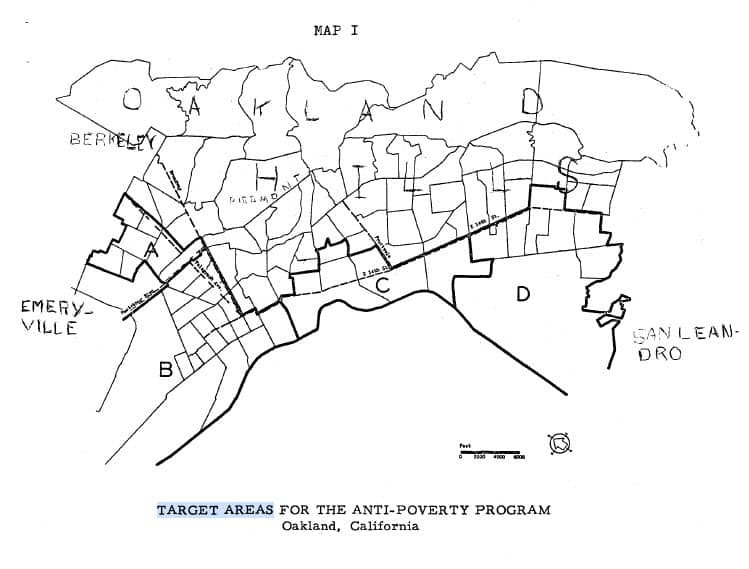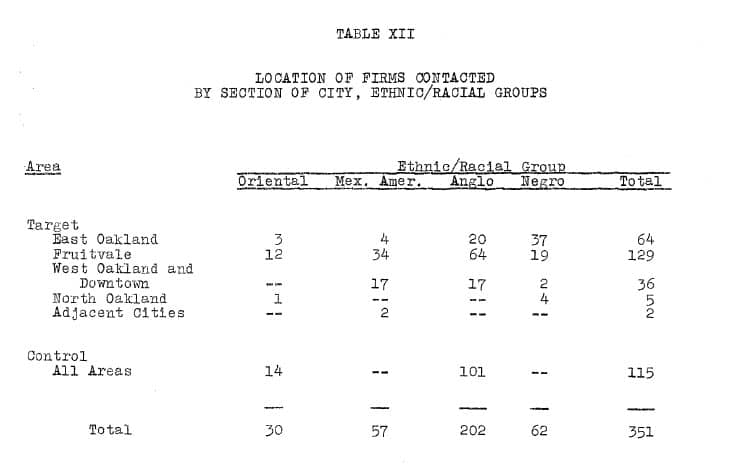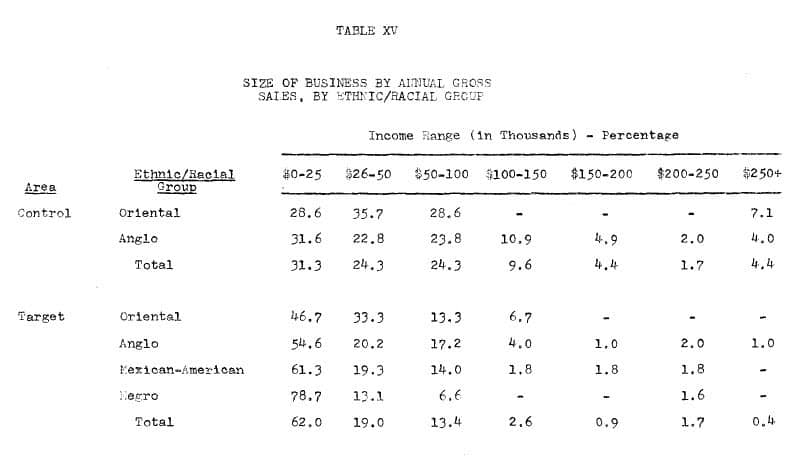
A study of the manpower implications of small business financing
by Joseph Debro
A 1968 book-length report, titled “A Study of the Manpower Implications of Small Business Financing: A Survey of 149 Minority and 202 Anglo-Owned Small Businesses in Oakland, California,” was sent to the Bay View by its author, Joseph Debro, prior to his death in November 2013, and his family has kindly permitted the Bay View to publish it. The survey it’s based on was conducted by the Oakland Small Business Development Center, which Debro headed, “in cooperation with the small businessmen of Oakland, supported in part by a grant, No. 91-05-67-29, from the U.S. Department of Labor, Manpower Administration, Office of Manpower, Policy, Evaluation and Research.” Project co-directors were Jack Brown and Joseph Debro, and survey coordinator was Agustin Jimenez. The Bay View is publishing the report as a series. A prolog appeared in the December 2013 Bay View, Part 1 in January 2014, Part 2 in February 2014, Part 3 in April 2014, Part 4 in May 2014, Part 5 in June 2014, Part 6 in August 2014, Part 7 in October 2014, Part 8 in November 2014, Part 9 in January 2015, Part 10 in March 2015, Part 11 in May 2015, Part 12 in October 2015, Part 13 in December 2015, Part 14 in May 2016, Part 15 in February 2017, Part 16 in March 2017, Part 17 in November 2017, Part 18 in May 2018, Part 19 in November 2018, and this is Part 20 of the report.
Chapter IV: Operation Business Breakthrough: A study of 351 small businesses in Oakland
Methodology
A survey of 351 Target Area and non-Target Area businesses was made from March 1 to Aug. 15, 1967. A pre-tested scheduled interview form was used for every firm. We endeavored to concentrate most of the Target Area interviewing along East 14th Street where Negro, Mexican American and Anglo, as well as Oriental enterprises were located in sufficient numbers for valid comparison.
Initially, as we sought to include as many small businesses as could be associated with those considered to be traditionally Negro (and to some extent Mexican American): “mom and pop” markets, restaurants, barber shops and beauty parlors, cleaning establishments, small appliance repairs, automotive repairs, and used clothing, furniture and appliance shops. [See Footnote l below.] In a preliminary survey of East 14th Street, 238 enterprises were located.

We discovered that Spanish surnamed businessmen were under-represented and that not every proprietor approached would respond to the interview. As a result, we were forced into other Target Areas of the city to locate the requisite number of Spanish surnamed merchants and to obtain in-depth materials for a limited number of businesses. In the process of locating in-depth data, it was necessary to interview entrepreneurs who did not fall within the seven lines of business enumerated above. The net result of these modifications was that the study became more diffuse, thereby offering insights into a wider spectrum of ghetto business problems.
Similar problems were encountered in the non-Target Areas. A great number of Anglos and a few Orientals refused to communicate with the research staff. No Black enterprises were located outside the Target Areas, and only one Spanish surnamed businessman, who was an officer of a corporation along with two other Anglos.
No attempt was made to match businesses in the Control and Target Areas. Certain businesses such as neighborhood groceries, shoe shine parlors and appliance repair shops are rapidly disappearing in the Control Area but are still to be found in the Flatlands. Very small restaurants are almost absent in the Hills but not in the Target Areas. Barber shops tend to be scattered evenly and non-competitively throughout the Control Area, while being clustered, sometimes five to six within a three to four block area in the Flatlands. Such differences made matching impossible.
“If you’re white, that’s all right; If you’re yellow, that’s mellow; If you’re brown, you can stick aroun’; But if you’re Black, get the Hell back!”
A scheduled interview form was employed in order to standardize as many queries and responses as possible. When Spanish-speaking persons were interviewed, the questionnaire was freely translated. In a number of cases, interviewers felt that they could not achieve or maintain a rapport relationship with the informant as long as the questionnaire was present; in order to circumvent embarrassing problems, most items were memorized and recorded immediately following the conversations with merchants.
In some instances, complete or reliable data was unavailable; in order to estimate incomes, estimates of gross sales of certain businesses were made by the staff. Credit checks were made on extremely doubtful cases in order to obtain additional information about certain respondents. All in all, the staff felt that most businessmen cooperated in the study, and that great interest in the forthcoming results was expressed both in the Target as well as Control Areas.
General characteristics of businesses
In general, those businesses located in the Control Area, when compared with their counterparts in the Flatlands, were tidier, situated in locations where a higher probability of survival was likely, were larger both in business volume and number of employees. (See Map I, Tables XII-XVI.) Anglo and Oriental entrepreneurs tended to have higher survival coefficients than Mexican Americans and Negroes, but this may be due to the latter two groups only having recently entered the business field as compared with Anglos and Orientals in Oakland.

Anglo merchants also tended to hire more persons than did Mexican Americans or Negroes, except in restaurants, where Mexican Americans surpassed other racial and ethnic groups in the uptake of employees. An overwhelmingly large percentage of Negro and Mexican American businesses were so small as to have gross annual sales no greater than $25,000. The old rhyme, so well known in the nether regions of American slums, is certainly apropos to minority business conditions in Oakland:
“If you’re white, that’s all right;
“If you’re yellow, that’s mellow;
“If you’re brown, you can stick aroun’;
“But if you’re Black, get the Hell back!”
The location of firms contacted by section of the city and by racial or ethnic grouping is given in Table XII. Although by no means restricted to that Target Area, the majority (54.7 percent) of our sample derived from Fruitvale, where all four ethnic or racial groups are fairly well represented in business; in that area, Anglo and Mexican American businessmen prevailed in numbers over Negroes.
East Oakland, on the other hand, has an ever-increasing number of Negro-owned businesses, and was represented by 37 Black entrepreneurs of 64 sampled there. In the Downtown section and West Oakland, the sample under-represents Blacks and over-represents Mexican Americans; this discrepancy arose late in the study when we realized that Spanish surnamed merchants in Oakland were almost absent, relative to this group’s numerical strength in the total population. We were forced to seek Spanish surnamed entrepreneurs in Downtown barber shops, beauty salons, markets and restaurants.

We entered Target Areas of North Oakland and in the city of Berkeley because certain clients of the Oakland Small Business Development Center were anxious to have their enterprises examined in detail by the research staff. Since the latter businesses are also in Target Areas, we have included them in this discussion, and for our purposes they are indistinguishable from those of the slums of Oakland.
Sixteen broad lines of business were studied, rather than the seven intended during the planning phase, and they are listed in Table XIII. Those lines which we initially intended to study (codes 01 to 07) still predominate in 61.2 percent of the total sample, but three additional lines – miscellaneous retail stores, artisans and service workers such as upholsterers and tailors, etc. and florists – make up a 23.6 percent of the total.

Entrepreneurs representing each racial or ethnic group in each of the 16 lines of business were not interviewed. Orientals were not represented in 11, Mexican Americans in five, and Negroes in two business lines; however, Anglos were to be found in all of these occupations. It is likely that in Oakland, Orientals and Blacks are to be found in all or most of those lines from which they are absent in our sample.
It is doubtful, however, that Mexican Americans in food processing and in general manufacturing are to be found in this city. Although second hand stores, pharmacies, general artisanry, and related services operated by Spanish surnamed individuals are known to exist, these businesses were not covered by this survey due to lack of time.
Businesses in this survey were very small when defined in terms of total number of persons working or in terms of annual gross sales (Tables XIV and XV). The median number of employed persons, including the proprietor, was about two in both the Hill and Flatland areas. The average number of employed persons in the Control Area was 4.3, while for the Target Area it was 3.2. Table XIV demonstrates wide differences in the average number of employed persons by racial or ethnic group. Anglos in the Control Area maintained the highest average with 4.4, while Orientals and Blacks maintained the lowest with 2.1 and 2.8 respectively.

Table XV demonstrates the relatively disadvantaged position of Mexican American and Negro businessmen in terms of gross annual sales. Yet such figures do not give a completely accurate picture. Although a barber shop grossing $50,000, for example, might be considered quite an important enterprise, such an amount would be considered almost nothing for a medium-sized grocery, retail appliance or clothing store.
The dimension of an enterprise, then, is not entirely one which underscores sales volume, but should be considered conjointly with the total number of employees utilized by the concern. By both of these criteria, Black and Mexican American businesses are smaller than Anglo Target Area establishments, and Target Area enterprises are smaller than those in the Hills. Furthermore, within the same lines of business, Anglos tend to have larger operations than their Negro or Mexican American counterparts.
Another index of relative success in business is the length of time an entrepreneur is established in any one location. This relationship is expressed by ethnic and/or racial group in Table XVI. Anglos were in business for a median of 7.4 years in the Control Area, and 10.7 years in the Target Area. In contrast to this very stable group, Mexican Americans and Blacks were located in their present sites for 2.9 and 2.5 years, respectively.
The median number of years of experience which each proprietor had in his line of business is also given in Table XVI. In the Control Area, Anglos had a median of 13.0 years, while Orientals had 14.2 years of experience. Very similar terms of total experience were found in the Target Area where Mexican Americans, Negroes, Orientals and Anglos had medians of 12.1, 13.5, 14.8 and 17.0 years of experience, respectively.
These data indicate that whereas minority entrepreneurs have approximately the same experiential background as Anglos, they are unable to survive at the same business location for many years.
Footnote 1: The term “small business” has been defined from time to time by various agencies of the U.S. government. The Reconstruction Act of 1944 (Public Law 458, 78th Congress) used the following definitions:

“A small plant means any small business concern engaged primarily in production or manufacturing either employing 250 wage earners or less or coming within such other categories as may be established by the head of such executive agencies in consultation with the chairman of the Board of Directors of the Smaller War Plants Corporation. Such other categories should be defined by taking into consideration the comparative sizes of establishments in a particular industry as reflected by sales volume, quantities of materials consumed, capital investments or by other criteria which are reasonably attributable to small plants rather than medium- or large-size plants” (quoted in Boutin, 1967: Exhibit A, pp. 2-3).
Another definition offered by the Selective Service Act of 1948 (Public Law, 759, 80th Congress) was:
“A business enterprise shall be determined to be ‘small business’ if (1) its position in the trade or industry of which it is a part is not dominant, (2) the number of its employees does not exceed 500, and (3) it is independently owned and operated” (quoted in Boutin, 1967: Exhibit A, p. 3).
The Small Business Administration bases its most recent (1967) loan standards definitions on the 1958 Census of Manufactures. Some examples of what SBA considers small are:
“Any construction concern is small for purposes of loan assistance, if its average annual receipts do not exceed $5 million for the preceding three fiscal years.”
“Any retailing concern is classified as small if its annual sales do not exceed $1 million.”
“The size standard provides that any concern producing less than 5 percent of the industry’s total output in the United States is small for the purpose of Government procurement of passenger cars” (Boutin, 1967: Exhibit A, pp. 6-7).
Based on these types of definitions, the SBA has been making loans averaging $43,800 (calculated from data presented in Boutin, 1967: Table XX). These loans are well in excess of the average annual gross volumes of business for entrepreneurs in our study. The businesses described in the above paragraphs are almost invariably corporations with large, professional staffs whose competence could easily be determined. Customary procedures used by banks could be employed to determine an applicant’s eligibility and qualifications in general.
These criteria cannot be used in the “mom and pop” type establishments discussed in this paper. We propose the terms “mini-business” and “micro-business” to describe two levels of very small enterprises observed throughout residential neighborhoods in the United States.
The micro-businessman is the simplest entrepreneur in the world – the sole proprietor who works alone, employs his family on a full- or part-time basis, and who hires no more than four outsiders. Most often, these enterprises do not have gross annual sales in excess of $100,000.
Ninety-nine percent of all minority businesses probably fall within this category. Proprietors often have no more than a high school education, and among Negroes, Mexican Americans and Puerto Ricans the average number of school years completed is less than 12. Hence, these enterprises are faced with a number of oft-times fatal management problems.
The mini-business, which is larger than the microbusiness, is one we define as an enterprise which employs less than 25 persons and which has gross sales not in excess of $1 million per year. The mini-businessman does not suffer from the educational disadvantages of the micro-businessman. Furthermore, such enterprises have a very high growth potential if adequate financing is available. Management problems are not nearly as fatal.
Joseph Debro, born Nov. 27, 1928, in Jackson, Miss., and a pillar of Oakland until his death on Nov. 5, 2013, was president of Bay Area Black Builders and of Transbay Builders, a general engineering contractor, former director of the Oakland Small Business Development Center and the California Office of Small Business, co-founder of the National Association of Minority Contractors and a bio-chemical engineer.





